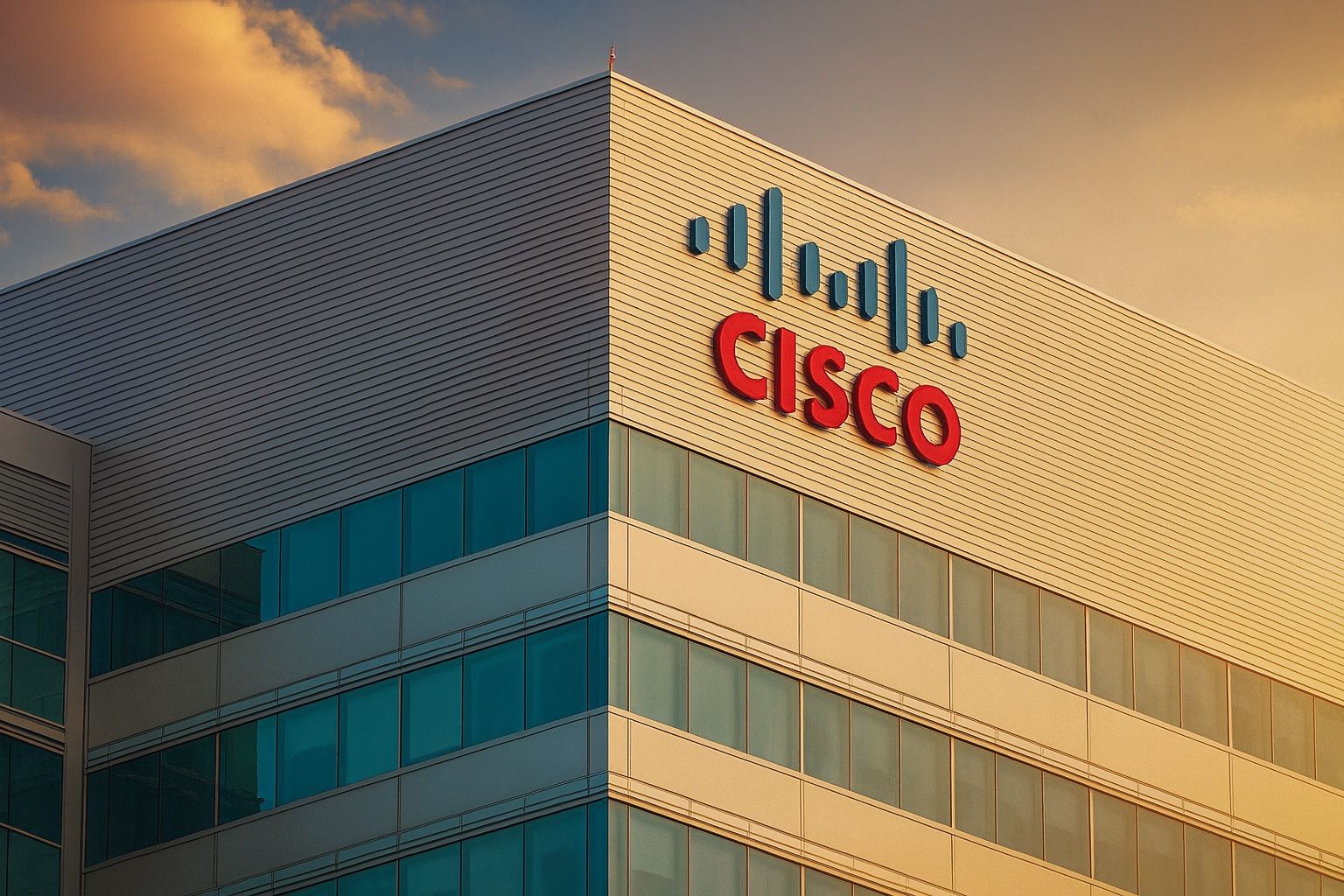- Stock Price: Cisco Systems (NASDAQ: CSCO) was trading around $69–$70 on Oct. 17, 2025, near its 52-week high (~$72.55) [1]. This marks roughly a 30% gain over 12 months [2].
- Recent Results: In fiscal Q4 (ended July 26, 2025) Cisco reported $0.99 EPS on $14.67B revenue, slightly above forecasts [3]. Revenue was up 7.6% year-over-year [4]. The company guided for 5–6% revenue growth in FY2026 (to ~$59–60B) and ~$4.00 in adjusted EPS [5], modestly beating Street estimates.
- AI and New Products: On Oct. 8, 2025 Cisco launched its new “Silicon One P200” chip and 8223 router (51.2 Tbps) to link AI data centers [6]. Early customers include Microsoft and Alibaba. Cisco’s AI-related orders exceeded $2 billion in FY2025 (more than double its initial target) [7]. CEO Chuck Robbins says Cisco aims to be a “core systems provider” for large AI clusters [8].
- Dividends & Valuation: Cisco recently raised its quarterly dividend to $0.41/share ($1.64 annualized), a ~2.4% yield [9]. At recent prices the stock trades around 17× forward earnings, well below many high-flying tech peers [10]. Cisco’s balance sheet remains strong despite the $28B Splunk acquisition (2024), with modest debt and robust free cash flow [11].
- Analyst Consensus: Wall Street’s consensus rating is “Moderate Buy”, based on roughly 15 Buy vs 10 Hold recommendations [12]. The average 12‑month price target (~$74–75) implies ~7–8% upside [13]. Some analysts are more bullish, with targets in the $80+ range [14].
CSCO Stock Climbs on Strong Quarter: Cisco’s stock has steadily climbed in 2025, even as many tech peers swung wildly during the AI frenzy. As of mid‑October, CSCO is trading just below its year-high [15] [16]. Over the past week the stock added roughly 2% on investor optimism around recent announcements [17]. Market observers note Cisco’s low volatility (beta <1) and broad support: shares have stayed above key moving averages (50-day ~$68, 200-day ~$65) [18]. “Cisco’s stock has been a steady performer in 2025,” TechStock² (ts2.tech) notes, ~31% higher than a year ago [19]. The company’s market cap is now ~$270 billion, making it one of the largest tech firms by value [20].
Earnings Beat and Bullish Guidance: The strong stock run follows Cisco’s solid Q4 results and upbeat outlook. The networking gear maker reported $0.99 EPS vs $0.98 expected, on $14.67B sales [21]. Product sales grew ~10% as webscale, cloud and service-provider customers ordered more networking hardware [22]. CEO Chuck Robbins called it a “strong close” to FY2025, driven by “accelerated innovation and solid execution” [23]. The company then raised its guidance, forecasting about 5–6% revenue growth for FY2026 (to ~$59–60B) and roughly $4.00 EPS [24]. That view slightly exceeded analysts’ prior estimates, reinforcing confidence. (After this August guidance, CSCO rallied in after-hours trading [25].) Reuters reports that Cisco’s CFO projects 9% revenue growth in FY2026, powered by strong demand for its Catalyst switches and recent edge-computing acquisitions [26] – again higher than many competitors’ forecasts.
Analysts point out that cloud and AI spending are underpinning Cisco’s outlook. Edward Jones analyst David Heger told Reuters that “enterprise spending… beef up the infrastructure to accommodate AI” could be a growth driver given Cisco’s big presence in that market [27]. In fact, Cisco said AI infrastructure orders in FY2025 topped $2 billion [28], well above its targets. On the recent earnings call, Robbins noted Cisco sees “sovereign AI” projects (like its Saudi and Bahrain deals) gaining traction in late FY2026, with Cisco positioned as a “core system provider” for large AI clusters [29] [30].
AI, Cybersecurity and Networking Innovations: Cisco’s management has been pushing the message that it is the backbone of the AI era. Earlier in 2025 the company unveiled a “Secure AI Factory” partnership with Nvidia, integrating Cisco’s new Silicon One chips and NVIDIA GPUs [31]. At Splunk’s 2025 conference (Splunk is the $28B Cisco acquisition for analytics/security), Cisco President Jeetu Patel proclaimed that Cisco would be “the critical infrastructure for the AI era.” He emphasized Cisco’s combination of high-performance, energy‑efficient networking; full-stack security; and data analytics (via Splunk) to address AI’s “infrastructure constraints, trust deficit, and data gap” [32].
On Oct. 8, 2025 Cisco introduced a 51.2Tbps “Silicon One P200” chip and 8223 router, targeting next-generation AI data centers [33]. Fierce Networks explains Cisco’s focus on “scale across” – avoiding packet loss between distant data centers – via a strategy of “deep buffering” in this new kit [34] [35]. Meanwhile, Cisco continues to sell its core switching and routing hardware (it remains the world’s largest networking vendor) and is pushing its catalyst series to hyperscalers and enterprises. Its security business (firewalls, SecureX platform, etc.) is also growing: Cisco holds about a 15.8% share of the global firewall market [36], and integrating Splunk’s analytics has boosted its visibility in cybersecurity.
Analyst Commentary and Targets: Wall Street reaction has been largely positive but measured. Analysts say Cisco’s valuation and dividend make it an appealing blend of growth and income. TechStock² notes the stock trades near 17× forward earnings with a ~2.4% yield [37] – cheaper than many tech peers – yet with steady mid-single-digit growth forecasts. Indeed, consensus projections call for roughly ~5% annual revenue growth and ~9% EPS growth through 2027 [38]. As one Nasdaq commentator put it, that is “solid for a stock trading at 17× and yielding ~2.5%” [39].
Optimists highlight Cisco’s execution and market shifts. For example, one analysis noted Cisco “delivered a strong close to FY 2025… indicating resilience despite challenges” [40]. Futurum Research observed that four of Cisco’s six largest web-scale customers have recently doubled their spending on Cisco gear, a sign of strong demand where Cisco “has carved out a key role” [41]. After the August quarter, several banks raised their price targets – JPMorgan to $78, Morgan Stanley to $70 [42], and notably Bank of America to $85 (up from $76) [43]. These analysts cite Cisco’s AI momentum, software pivot and shareholder returns as bullish factors. CEO Robbins himself told investors, “We hit the top end of our guidance and see massive opportunity ahead,” underscoring management’s confidence [44].
Risks and Cautions: Not everyone is convinced Cisco will re-rate as a high-growth stock. Skeptics point out that despite AI tailwinds, Cisco’s core networking hardware business is mature. In fact, Cisco’s long-term revenue growth has averaged only ~1.7% annually over the past decade [45]. Some warn that if companies delay hardware upgrades or move more services to software/cloud providers, Cisco’s sales could slow. As one critic bluntly quipped, “when I think of Cisco, one word comes to mind: Average,” reflecting the view that Cisco is solid but not a runaway leader [46]. Cisco also faces stiff competition: Arista’s stock has soared thanks to cloud switching wins, and other rivals (Juniper, HPE, Huawei) are pressing into Cisco’s turf [47]. Moreover, weaker public-sector orders (recently down ~6% year-over-year [48]) and the costs of integrating Splunk (higher R&D, expenses) keep some analysts cautious.
Outlook – Steady Growth Ahead: Overall, the consensus is “cautiously optimistic.” Most analysts expect Cisco’s stock to trend upward steadily as long as the company meets targets and enterprise/AI spending stays healthy [49]. Technical analysts note near-term resistance around the $72–73 zone (the recent peaks) and support in the mid-$60s (200-day moving average) [50] [51]. If positive news or strong earnings push CSCO above that range, a move into the mid-$70s could follow. Longer-term (2–5 years), Cisco’s trajectory depends on its strategic pivot to software and services. The company aims to have over half its revenue from software/subscriptions in the next few years [52]. If this transformation succeeds, some argue Cisco could earn a higher valuation multiple – closer to software peers [53]. But if growth remains modest, Cisco may trade more as a steady, defensive tech stock with modest upside.
For now, Cisco blends growth and yield. With a history of 15+ years of uninterrupted dividends and aggressive buybacks, it returns capital even while funding new AI initiatives [54] [55]. Investors watching CSCO will likely focus on upcoming earnings (next report due Nov. 2025) and any further AI/product announcements. As one analyst summarized: Cisco is “positioned to benefit disproportionately” from rising demand in networking and AI infrastructure [56], but must execute flawlessly to justify its renewed optimism.
Sources: News and analysis from Cisco’s investor calls and reports, MarketBeat, Reuters, TechStock² (ts2.tech), Fierce Networks, Indian Express, and other financial media [57] [58] [59] [60]. Hyperlinks provided inline.
References
1. ts2.tech, 2. ts2.tech, 3. ts2.tech, 4. ts2.tech, 5. ts2.tech, 6. ts2.tech, 7. ts2.tech, 8. ts2.tech, 9. ts2.tech, 10. ts2.tech, 11. ts2.tech, 12. ts2.tech, 13. ts2.tech, 14. ts2.tech, 15. ts2.tech, 16. ts2.tech, 17. ts2.tech, 18. ts2.tech, 19. ts2.tech, 20. ts2.tech, 21. ts2.tech, 22. ts2.tech, 23. ts2.tech, 24. ts2.tech, 25. ts2.tech, 26. www.ainvest.com, 27. www.reuters.com, 28. ts2.tech, 29. www.reuters.com, 30. ts2.tech, 31. indianexpress.com, 32. indianexpress.com, 33. ts2.tech, 34. www.fierce-network.com, 35. www.fierce-network.com, 36. markets.financialcontent.com, 37. ts2.tech, 38. ts2.tech, 39. ts2.tech, 40. ts2.tech, 41. ts2.tech, 42. ts2.tech, 43. ts2.tech, 44. ts2.tech, 45. ts2.tech, 46. ts2.tech, 47. ts2.tech, 48. ts2.tech, 49. ts2.tech, 50. ts2.tech, 51. ts2.tech, 52. ts2.tech, 53. ts2.tech, 54. ts2.tech, 55. ts2.tech, 56. www.ainvest.com, 57. ts2.tech, 58. www.reuters.com, 59. indianexpress.com, 60. ts2.tech







